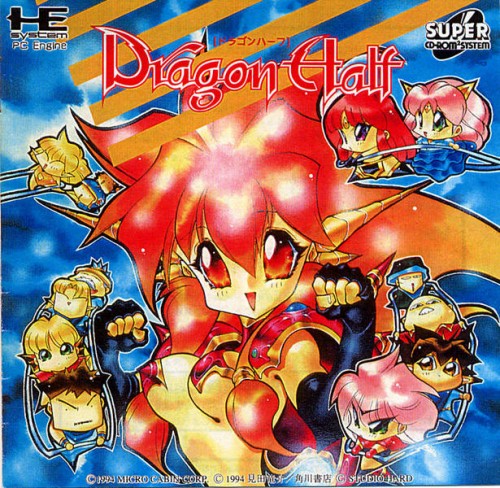
Seven Seas ended 2018 by releasing their third and final omnibus volume of Ryusuke Mita’s famous Dragon Half manga in English, and in doing so concluded a nearly two-year-long campaign to re-introduce this famous property to the Western world. This move began in 2017, with Crunchyroll breaking its unspoken sub-only rule and offering the 1993 OVA adaptation’s dub by ADV Films on its platform. Following that, Discotek Media rescued the physical distribution rights and released the adaptation on DVD and Blu-Ray at the end of that year, right before Seven Seas began publishing their omnibuses of the original manga. That’s a lot of people to push a relatively small franchise, especially one that’s over 20 years old, but looking at the history and context behind Dragon Half’s creation reveals poignant social commentary that makes it just as relevant to modern Japan and even to the rest of the world.
First, a Little Background
Dragon Half follows Mink, a normal teenage girl who doesn’t get along with her parents and adores pop singers. The only thing that really stands out about her (massive 80s hairstyle notwithstanding) is that she is biracial, having been born from a human and a dragon, or a Dragon Half as the series puts it.
The Half part comes from the term Hafu, a loan-term from the English word “half” used in Japan to describe those of mixed race, just like Mink. It’s a bit hard not to interpret that term as a pejorative, but it’s arguably one of the nicest aspects of the way Hafu can be treated in mainstream Japanese society. This stigma is thought to have begun after the Second World War, when many soldiers from the United States Armed Forces lived in Japan, resulting in an influx of children being born from American fathers and Japanese mothers.
These families rarely ever received support of any kind from their American fathers, reducing the mothers and children to social pariahs since out-of-wedlock pregnancies, mixed-race couples, and single parent status were all about as accepted in 1940s Japan as they were in 1940s America. As a result, simply being Hafu became associated with taboo statuses, leading to heavy discrimination. Hafu from all backgrounds are routine targets for bullying in schools with staff reportedly doing little to nothing to stop it and many employers completely refuse to hire any who is anything but purely Japanese, even if the prospective employee otherwise integrates into Japanese culture perfectly.
We’re Finally Going to Talk About Dragon Half Now
If you’ve already read or watched Dragon Half, then you already know some of the ways it directly connects to the story of Hafu. Mink is the daughter of a soldier and experiences discrimination due to her biracial heritage, being hunted and attacked by her favorite teen-idol and Princess Vena—the president of his fan club—after they notice her dragon features. Interestingly, the president is also Hafu, being part slime, but she passes as a human due to a lack of any noticeable slime characteristics.
The fact that the Hafu characters’ foreign genes are allegorically represented as monstrous is a clear comment on the hate people of mixed backgrounds experience in Japanese society and Vena’s backstory expands on this, as many Hafu who can pass for Japanese (like those with a background from another Asian country) are able to be accepted among their peers by keeping their ethnic status a secret, thus being accepted into mainstream society at the cost of having to hide who they are.
Vena is not the only one to choose this path though, as when Mink realizes she won’t receive the acceptance she longs for unless she’s fully human, she sets out to find the fabled pido potion, said to make anyone who drinks it into a human. The ensuing events mostly consist of quick gags and comedic antics—the story is first and foremost a parody of RPG games, after all—but Mink’s adventures through it all teach her to appreciate the traits given to her by her dragon half, such as being able to shed her skin to escape a trap and mostly having super-strength and fire-breath. Let’s be honest, most things in life would be easier to manage with super-strength and fire-breath.
Sixty-six chapters and one slain demon king later, Mink finally finds the pido potion, but chooses not to drink it because of how she has come to accept her dragon features thanks to the experiences she’s had and the friends she’s made who accept her for who she is (And one of said friends needing the potion to undo a spell that turned her into a frog also probably helped). This acceptance is at the core of Dragon Half’s message and its denouement serves as a curtain call for the different forms of acceptance for Hafu gained by the cast. Vena comes out as half slime while Mink wins the respect of her peers and the love of pop music sensation and undefeated champion of silly names, Dick Saucer as those who once antagonized her for the circumstances of her birth celebrate her triumph, teaching the reader to avoid racial prejudices like those experienced by Hafu in Japan and by extension to reject racism altogether.
Final Thoughts

While Dragon Half holds up on the strength of its fast-paced gags and clever lampooning of RPG tropes, its cultural relevance today lies heavily in its commentary on racial prejudices in its country of origin. Racism remains a problem the world over though, and the way the franchise confronts such biases while remaining lighthearted and funny ensures that it will have a place in just about any culture. We’re lucky to have Dragon Half back in North America and we hope other regions will be just as fortunate in the future.


